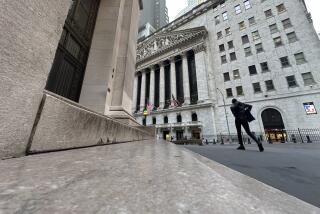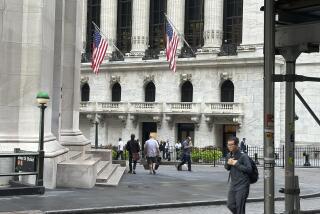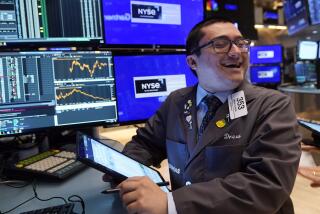WORLDWIDE SELL-OFF HITS WALL STREET
- Share via
Stock prices plunged worldwide Tuesday, in a wild rout that could signal a threat to the global economic boom.
A sell-off that began in Chinese shares -- on rumors of government moves to curb that highflying market -- spread to Europe and the Americas and left Wall Street with its worst one-day drop in nearly four years.
The Dow Jones industrial average ended down 416.02 points, or 3.3%, at 12,216.24, wiping out its last three months of gains.
In one measure of the day’s drama, the blue-chip Dow appeared to plummet almost 200 points in an instant near the end of the trading session. The suddenness of the drop was later attributed to a computer glitch.
Glitch or not, there was no question that many investors were bailing out. Within the Standard & Poor’s index of 500 major stocks, only two issues rose for the day.
The markets’ tumult was a reminder of how quickly money can move around the globe.
Yet by the close of trading today in China, some investors already had returned to its battered market. Shanghai’s main stock index rebounded 3.9% after Tuesday’s 8.8% dive, the biggest one-day drop in a decade.
Now the issue is whether the selling will quickly abate in other markets. A sustained slide would raise the question of whether the widespread investor enthusiasm that has underpinned the world economy and financial markets for four years was rapidly ebbing.
Investors’ optimism has been evident in their willingness to pump huge sums into what have long been considered high-risk markets: for example, Chinese stocks, commodities like copper, and bonds backed by so-called sub-prime mortgages made to U.S. home buyers with poor credit histories.
Many such high-risk investments sank the fastest Tuesday. In the case of sub-prime mortgages, that market has been unraveling for months as a growing number of homeowners have defaulted on their loans.
Investors’ sudden losses in those markets are “a reminder to people about risk, and it’s a good reminder,” said James Glassman, an economist at JPMorgan Securities in New York.
That was one prevalent view Tuesday on Wall Street. The other was that markets were primed for a sharp decline simply because they have gone so long without one -- leaving many investors with trigger fingers, eager to take some of their profits.
A pullback in stocks “has been long overdue,” said Larry Adam, investment strategist at brokerage Deutsche Bank Alex. Brown in Baltimore.
Despite the severity of the selling Tuesday, the percentage declines in the major U.S. stock indexes didn’t come close to their historical record losses.
The market crash of Oct. 19, 1987, for example, saw the Dow crumble 22.6% in one session.
The index fell 7.1% on Sept. 17, 2001, the first trading day after the 9/11 terrorist attacks.
With the Dow at a much higher level now, “Not to make light of 400 or 500 points, but this is a natural market correction,” said Robert W. Bissell, president of Wells Capital Management in Los Angeles.
Global stock markets also suffered a sharp setback from mid-May to mid-June. Since then they’ve been on fire again as money has poured back in.
The Dow rose seven straight months through January, its longest winning streak since 1995.
The 30-stock Dow on Oct. 3 finally surpassed its peak of 11,722.98 reached in January 2000, and followed that with a succession of new highs.
Share prices also powered to record highs in many foreign markets, including China. Through Monday, the Shanghai market index had rocketed 77% in five months. The Mexican stock market surged almost 30% in the same period.
Underlying investors’ hunger for stocks was faith that the global economic expansion would continue, and with it that corporate earnings would continue to rise, analysts say.
The Federal Reserve helped to stoke that sentiment when it stopped raising short-term interest rates last August after lifting them for two years.
In the U.S., Wall Street had shown enormous faith that the Fed’s credit-tightening campaign had engineered an economic “soft landing” -- a slowdown this year that would restrain inflation and set up the economy for strong growth in 2008 and beyond.
But that faith has been shaken in recent days. One rising concern is that the troubles in the sub-prime mortgage market could deepen the housing market’s woes and in turn pull the broader economy down.
Some investors also were taken aback after former Fed Chairman Alan Greenspan said in a speech Monday that the U.S. economy could tip into recession late this year.
On Tuesday morning the government said that orders for big-ticket factory goods tumbled 7.8% in January, suggesting a reluctance by businesses to spend money on expansion.
China had already set the downbeat mood by the time U.S. markets opened. The spillover from its market plunge was another reminder of how important the nation’s economy and markets have become to the world.
After China’s market sank, European stocks also dived. When U.S. trading opened the Dow quickly tumbled 142 points. It drifted steadily lower until late afternoon, when it suddenly spiraled downward.
At one point the Dow was off nearly 550 points before rebounding somewhat.
Some of the late sell-off was blamed on confusion after an apparent computer system error at Dow Jones & Co., the keeper of the Dow average, made it seem as if a nearly 200-point drop had happened almost instantaneously.
The New York Stock Exchange said its systems then were taxed by capacity issues as sell orders flowed in. Investors didn’t appear to discriminate, dumping smaller stocks as well as shares of big-name companies.
The selling wave Tuesday raised fresh concerns about the rapid-fire trading strategies employed by many hedge funds, private investment pools that have exploded in popularity with well-heeled investors over the last decade.
“You have huge amounts of money sitting in hedge funds,” Bissell said. “Their holding period is measured in days, not years.”
John Buckingham, a Laguna Beach-based mutual fund manager, noted that the idea of a “global capital glut” -- markets awash in money from investors seeking high returns -- has been the basic explanation for stocks’ continued gains.
But that glut also poses the danger of rapid market reversals, Buckingham noted.
“There’s so much money out there, when it sloshes from one side of the tank to the other it can have a tremendous effect,” he said.
Yet many experts say that if the U.S. economy is on track for a soft landing, it may not take long for hedge funds and other investors to come back to the stock market.
Likewise, analysts note that the robust corporate takeover activity that has helped lift share prices over the last year may ramp up further if stocks pull back, giving potential acquirers cheaper prices.
On Sunday, Texas utility company TXU Corp. agreed to a $32-billion takeover by private investment groups, the largest such buyout in history.
A key concern, however, is that a sustained drop in stock prices could cause investors’ appetite for all sorts of high-risk investments to dim.
If investors pull back significantly, that could cut off capital to many companies and other borrowers worldwide, taking away the grease that is crucial for the economy’s continued expansion.
Many analysts say those worries are overblown.
Although the Fed and other central banks have raised interest rates in recent years, the cost of money still is relatively low, historically, said Michael Darda, economist at MKM Partners in Greenwich, Conn.
“Global financial conditions remain accommodative, not restrictive,” he said.
Brian Wesbury, economist at First Trust Advisors in Lisle, Ill., said that there was no convincing evidence that the economy was veering toward a slowdown so severe that it would cause investors to lose faith in markets.
“There’s no fundamental problem with the economy, either globally or in the U.S.,” Wesbury said.
*
Petruno reported from Los Angeles and Hamilton reported from New York.
*
Begin text of infobox
The Dow’s dive
The Dow’s tumble included a plunge of nearly 200 points after a computer glitch delayed the reporting of trades.
Dow Jones industrial average’s Tuesday path by the hour
[Please see microfilm for full chart information]
Open:
12,628.90
Close:
12,216.24
Eastern Standard Time
---
How much major stock markets around the world dropped Tuesday, and their changes so far this year.
*--* Pctg. chng.: Pctg. chng.: Market/index Tues. YTD China/Shanghai composite -8.8% -3.6% Brazil/Bovespa -6.6 -3.0 Mexico/IPC -5.8 -0.1 U.S./Nasdaq -3.9 -0.3 U.S./Dow 30 -3.3 -2.0 Russia/RTS -3.3 -0.8 Germany/DAX -3.0 +3.4 Canada/S&P-TSX; -2.7 +1.0 Britain/FTSE -2.3 +1.1 Japan/Nikkei 225 -0.5 +5.2
*--*
---
Source: Bloomberg News
**
fi-2markets28BOX
Steep declines for the Dow
Largest one-day percentage drops in the Dow Jones industrial average compared with Tuesday’s decline
*--* Points Pctg. Date lost change: Dec. 12, 1914* -17.42 -24.4% Oct. 19, 1987 -508.00 -22.6 Oct. 28, 1929 -38.33 -12.8 Oct. 29, 1929 -30.57 -11.7 Nov. 6, 1929 -25.55 -9.9 Feb. 27, 2007 -416.02 -3.3
*--*
*New York Stock Exchange reopened after closing for four months because of World War I.
Sources: Times research
More to Read
Inside the business of entertainment
The Wide Shot brings you news, analysis and insights on everything from streaming wars to production — and what it all means for the future.
You may occasionally receive promotional content from the Los Angeles Times.










